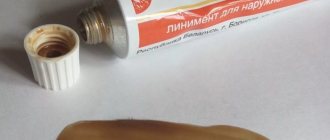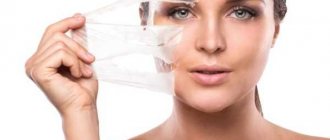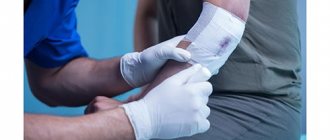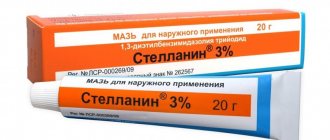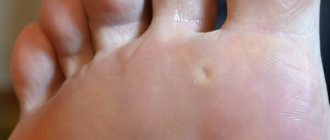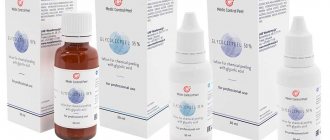Calluses
occur in places where the skin experiences constant friction or pressure. By forming a callus, the body tries to protect itself from this adverse effect.
First there is a wet callus
- a bladder filled with liquid - lymph. Lymph is needed for the speedy healing of damaged tissues. If the mechanical irritation stops, new skin forms under the blister and the callus disappears.
If the external influence continues, the body begins to build up a protective layer of dead, horny cells. Dry callus appears
, looking like a white-yellow compaction, usually with round outlines.
Calluses form on the hands (during physical work) and on the feet (on the heels or toes). As a rule, it is foot calluses that worry us.
What happens if you puncture a callus?
If you pierce it, the following will happen:
- The liquid will flow to the surface of the skin.
- The skin covering the callus falls off.
- The pain goes away because there is no longer the tension caused by the fluid accumulated inside the callus.
- You can now step on your sore leg again.
On the other hand, after a puncture a wound is formed.
She needs to be looked after.
Otherwise, infection may occur.
Causes of calluses
Human skin is a thin layer of tissue that is easily damaged. Increased friction leads to hardening of the dermis. Cells do not have time to recover and change. The appearance of corns can be associated with uncomfortable shoes - wearing heels requires you to monitor the condition of your feet. Stiletto heels have a negative effect - they compress the forefoot, and girls find deep corns near their toes. Active movement has a similar effect: calluses can appear on the skin of the toes.
For a person with a congenital foot deformity, the occurrence of calluses may become commonplace, but even if they appear frequently, they should not be treated negligently.
Should a baby's water blister be pierced?
Children are in places that are not the most sterile.
It is difficult to keep track of a school-age child.
It is unlikely that it will be possible to control it constantly.
Therefore, you need to understand that sooner or later the child will damage the callus.
This is unlikely to happen under aseptic conditions.
And it is unlikely that at this moment the baby would have cotton wool with brilliant green in his hand.
Therefore, the wound will not be treated.
An infection can get inside.
In the future, suppuration is possible.
To avoid all these consequences, it is better to pierce a large callus immediately, treat it with antiseptics, and then cover it with a band-aid.
After a few days, the damaged area will heal.
Children's skin heals faster than adults'.
Features of purulent calluses
Speaking of purulent calluses, medicine categorically prohibits the removal and puncture of such formations at home. Only surgical intervention is recommended. Doctors are obliged to prevent the formation of calluses and their transformation into purulent formations that require surgical operations. An ordinary blister can turn into a purulent formation within a week.
Regardless of the type of callus on the hand or foot, you should consult a doctor. The doctor will recommend an option for getting rid of the callus. The consequences of the development of certain types of calluses can be serious; it is better to prevent the formation of damage and immediately combat the appearance, without starting the development process for a long time.
Purulent callus
How to pierce a callus incorrectly?
So, you decided to pierce the callus.
You should immediately familiarize yourself with the main mistakes made by those who get a puncture for the first time.
Let's talk about how a careless “self-taught surgeon” punctures a callus on the foot.
He does this as follows:
- He takes the first needle he comes across.
- To keep it clean, wash it with water or wipe it on your pants.
- Takes off shoes on unwashed feet.
- With a flourish he thrusts the needle into the very center.
- He tries to quickly squeeze out the liquid from the callus by pressing on it with his finger.
- Wipe the problem area with a napkin.
- He puts on a sock and goes about his business.
It is likely that even this approach will lead to success.
But at each stage, serious mistakes were made that could lead to complications.
Basic rules of asepsis and antiseptics are not followed.
Incorrect puncture technique can lead to damage to the deep layers of the skin, which can lead to scarring.
Squeezing out the fluid can cause rupture of the skin covering the callus, which protects the wound from infection.
After the puncture, the wound is not treated or covered with a plaster.
Prevention
Prevention involves eliminating factors that can cause disease before the disease occurs. Such a factor in the case of calluses is uncomfortable or not yet worn shoes. Based on past experience and understanding that buying new or wearing uncomfortable but favorite/fashionable shoes causes calluses, and knowledge of the most common places for them to appear, a person can take appropriate measures:
- in places where it is possible, use silicone pads;
- in areas where there is no room for silicone pads, use patches, gluing them in advance;
- You can start wearing new shoes at home for several hours until discomfort appears and after several repetitions they will fit in the right places;
- always keep your feet dry;
- areas that are subject to slight pressure but suffer from strong friction can be treated with Vaseline on top of the patch (the patch is glued on, and a layer of Vaseline is applied on top of it).
One way to prevent calluses on your toes is with soft pads.
How to properly pierce a callus?
Now let's talk about how to pierce a callus correctly to prevent complications.
- Take a needle without a cavity. The cavity is contained in a syringe needle. There is no cavity in a surgical or sewing needle. Most people do not have surgical needles at home. But there is always a sewing room. It is quite suitable for performing a puncture.
- Sterilize the needle. To do this, just dip it in alcohol.
- Treat the area of the upcoming puncture with an antiseptic. Iodine or alcohol will do. Wash your hands thoroughly and wear rubber gloves. If you don’t want to run to the pharmacy to get them, at least wipe your hands with alcohol.
- Make a puncture not in the center, but on the side of the callus. Insert the needle not at a right angle, but almost horizontally. This will avoid unnecessary damage to the skin.
- The liquid should come out on its own. And if it comes out too slowly, make another puncture. If the hole is small, there is no point in pressing on the callus. Because due to increased pressure, the skin will simply burst. As a result, instead of a small hole in the skin, a wound is formed, which will subsequently take longer to heal and may become infected. If the hole in the skin is sufficient or there are several of them, you can press on the callus. But this can only be done with a sterile napkin. If it is initially non-sterile, it should be soaked in an antiseptic solution.
- After all the liquid has come out, treat the affected area with iodine.
- Apply germicidal patch. You can use a regular patch, but it must be sterile.
Symptoms
Wet calluses have characteristic signs that are always related to external strong effects on the skin. This distinguishes it from a serious disease - pemphigus.
Clinically, on the skin in an area previously damaged by external influences, a bubble filled with liquid is observed, painful when touched. It has clear boundaries and a zone of inflammatory redness along the periphery. The liquid is often clear, but can be whitish (with impurities of pus), with blood (if blood vessels are damaged) or have a purulent nature (if infected). In the latter case, the rim of hyperemia around the bubble can reach up to 1 cm in width.
The duration of existence depends on the size and location. Thus, calluses on the back of the heel, on the hand at the base of the fingers, on the little toe last the shortest time, compared to other locations - they are usually destroyed by shoes or during everyday manipulations immediately after formation. They are the ones most often infected.
One of the most common locations for wet calluses is the back of the heel.
Calluses on the balls of your feet last longer. This is due to the fact that they are usually formed after the influence of the factor that caused them has ceased - at the end of the day, after the shoes are removed - in the evening or at night. Having woken up and felt acute pain, such a person, as a rule, observes gentle or even bed rest, which prolongs the existence of the bladder.
Does it hurt to pierce a callus on your foot?
The puncture may be somewhat painful.
But this pain will not be very strong and short-lived.
After the puncture, the pain will decrease.
Because the pressure exerted on the tissue by the liquid contained inside will go away.
There will be no pain when walking, or it will become very weak.
The puncture site will heal quickly.
In the future, pain is possible only if the callus becomes inflamed.
There are also cases when a callus forms in the same place after a short time.
She fills up with fluid again.
In this case, the puncture should be repeated.
For large calluses, it is better to consult a doctor.
Callus and then
While any person can “earn” a callus, for athletes and people in certain specialties this injury can be a “professional” injury.
For example, weightlifters have wet calluses on their palms over time turning into dry ones. In track and field athletes, football players and military personnel, calluses most often occur on the feet - in the heels, toes - and are associated with prolonged running or walking. The palms are a “weak” place in terms of the formation of wet and then dry calluses in people engaged in physically difficult work.
But, surprisingly, people who suffer from a lack of physical activity and avoid physical labor in principle are also at risk. This case is best characterized by folk wisdom: “A lazy person at work is a callus on the body.”
The vast majority of people do not consider callus a medical problem precisely because they know the cause of its appearance and the fact that it does not require active treatment. Nevertheless, it is possible and necessary to speed up the healing of calluses. What should I do for this?
I pierced a callus - what to do?
It happens that the callus is punctured by accident.
It bursts and liquid pours out.
At this moment the person feels pain.
In such a situation, the risk of infectious complications is higher.
But it can be reduced if you take action immediately after the callus ruptures.
You need to do the following:
- Treat the skin with an antiseptic. For example, iodine or hydrogen peroxide.
- Cover the problem area with cotton wool and antibacterial ointment. The pharmacy sells antibiotics. For example, Levomekol or tetracycline ointment. Antiseptics will also work. Do not use the solution. You only need to apply the ointment under the bandage. Otherwise it will dry out. It will have to be soaked or peeled off along with the skin.
- Treat with iodine once a day until healing. In most cases, these measures prevent infectious complications. But if signs of inflammation still appear, you should see a doctor. The wound may need to be treated. Otherwise, a purulent focus may form.
Properly opening a callus: medical recommendations
The method of properly opening a callus depends directly on the type. For example, it is better to simply seal small water bubbles with a bactericidal patch without paying too much attention. If we are talking about large calluses that are about to burst, it is recommended to open the formations, but extremely carefully and accurately. Even a large bubble cannot burst like a simple balloon. A number of rules have been developed:
- the puncture is performed within twenty-four hours after the formation of a blister on the skin;
- Before opening, the surface of the blister will need to be treated with hydrogen peroxide, the needle will need to be heated over a fire or simply treated in an alcoholic liquid;
- you need to pierce the callus from the side: the main requirement is not to touch the bottom of the formation, which is located to the occurrence of inflammatory processes. The dome of education must remain intact;
- It is recommended to make two punctures: this is done in order to prevent rupture of the skin, which has a beneficial effect on the outflow of fluid from the bladder;
- the liquid from the blister is removed using a sterile bandage or cotton wool, the skin is treated by tightly pressing cotton wool previously soaked in peroxide;
- prevent possible infection of the affected areas of the skin: the wound is lubricated with brilliant green or ointment with a special antibiotic effect. It is forbidden to lubricate with alcohol;
- When the callus has been punctured, a bactericidal patch is applied or a bandage is used as protection; it should be changed at least twice a day.
Features of callus piercing are considered in each individual case, depending on the type and degree of development on the human skin. The decision to puncture or preserve the blister is made on an individual basis. Before the procedure, it is better to first consult with a professional. The manipulation is carried out at home or in beauty salons. In any case, the main requirement for piercing remains sterility and protection from infection.
Is it possible not to pierce the callus?
There is no need to puncture the callus if you think that it will definitely not rupture on its own.
This is possible if the callus is very small or is located on a non-load-bearing area of the body.
True, this rarely happens.
After all, education is formed precisely because of constant or short-term excess load.
If the callus is not punctured, it will disappear within a week.
But if you believe that there is a risk of rupture, it is better to still perform a puncture.
If you do this in a timely manner, under sterile conditions, with sterile instruments, then with a probability close to 100%, you will be able to avoid infectious complications.
Why do calluses appear?
Friction, pressure and wet skin are three key factors that are guaranteed to lead to calluses.
On a vulnerable area of the skin, under the influence of friction and/or pressure, a blister filled with liquid appears - a callus. The fluid may be clear or mixed with blood; this happens when the blood vessels at the site of the callus are located close to the surface. However, calluses do not appear everywhere and not always. The likelihood of such an injury increases significantly if the area of skin affected is wet.
The purpose of one of the studies, the results of which were published in the official journal of the International Society of Biophysics and Skin Imaging, was to find ways to prevent the appearance of calluses. Scientists have experimentally found that increased hydration of the skin surface (excessive moisture) increases the rate of change in skin temperature in response to the application of force (pressure, friction) and, therefore, increases the likelihood of the formation of wet calluses.
In the vast majority of cases, the callus does not require specific treatment and disappears on its own within 1-2 weeks (provided that the injured area of skin is not subjected to repeated damaging effects). But in some cases, medical assistance may still be needed, for example, when the callus is extensive, located in an inconvenient place and greatly interferes with everyday life.
If the callus is opened, an infection has entered the wound and an active inflammatory process has begun, medical care is required.

